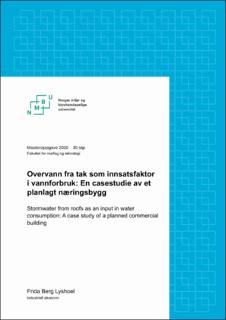| dc.contributor.advisor | Shiferaw, Asmamaw Tadege | |
| dc.contributor.advisor | Aksnes, Håkon | |
| dc.contributor.author | Lyshoel, Frida Berg | |
| dc.coverage.spatial | Norway, Oslo | en_US |
| dc.date.accessioned | 2021-02-05T16:59:26Z | |
| dc.date.available | 2021-02-05T16:59:26Z | |
| dc.date.issued | 2020 | |
| dc.identifier.uri | https://hdl.handle.net/11250/2726507 | |
| dc.description.abstract | Tilgang til rent drikkevann er en av de største utfordringene vi står ovenfor i nyere tid, blant annet på grunn av befolkningsvekst, urbanisering, forurensning og klimaendringer. Klimaendringer fører også til større mengder nedbør på kortere tid. Ledningssystemer som ikke er dimensjonert for å håndtere økte nedbørsmengder i fremtiden kan skape problem og få store økonomiske konsekvenser, spesielt i byer og tettsteder. Urban fortetting, økte nedbørsmengder, samt færre grøntområder som naturlig håndterer vannet, vil gjøre at den tradisjonelle metoden for overvannshåndtering i lukkede rørsystemer møter på utfordringer i form av overbelastning. For å løse disse utfordringene kan utnyttelse av overvann som ressurs være et viktig bidrag, fordi det reduserer det totale trykket på ledningsnettet og reduseres forbruk av drikkevann. Oppgaven undersøker gjennomførbarhet og potensialet for effektiv vannbesparelse og lønnsomhet knyttet til oppsamling av regnvann på tak i kontorbygg. Oppgaven er en mulighetsstudie av det planlagte næringsbygget Construction City på Ulven i Oslo. For de to alternative oppsamlingsarealene i denne oppgaven er det mulig å oppnå en effektiv vannbesparelse på henholdsvis 37% og 52% frem mot 2050. Det er en utbredt oppfatning av at bærekraftige bygg er vesentlig mer kostbart å bygge enn tradisjonelle bygg. Til tross for stort potensiale for vannbesparelse, viser nåverdiberegningene at verken alternativ 1 eller alternativ 2 kan sies å være direkte økonomisk lønnsomme. Sosial aksept, mangel på teknologisk kunnskap og fravær av insentiver skaper barrierer for at flere gjennomfører innovative og bærekraftige tiltak i nybygg. I tillegg kan politisk engasjement og strengere myndighetskrav bidra til at det i fremtiden ikke skal lønne seg å la vær å bygge bærekraftig og innovativt. | en_US |
| dc.description.abstract | Access to safe drinking water is one of the biggest challenges we face in recent times, partly due to population growth, urbanization, pollution and climate change. Climate change also leads to larger amounts of precipitation in a shorter time. Pipe systems that are not dimensioned to handle future climates can have major economic consequences, especially in cities and towns. The traditional method for stormwater management in closed pipe systems is facing challenges such as congestion of water and sewage networks as well as fewer green areas that can naturally handle the water, due to urban densification. To solve these challenges, the utilization of stormwater as a resource can be an important contribution, because it can reduce the total pressure on the water and sewage network and reduce the consumption of drinking water. This thesis studies feasibility and the potential for water saving efficiency and profitability related to rainwater harvesting from roofs in office buildings. The thesis is a feasibility study of the planned commercial building Construction City at Ulven in Oslo. For the two alternative collection areas in this project, it is possible to achieve a water saving efficiency of 37% and 52% by 2050, respectively. There is a widespread perception that sustainable buildings are significantly more expensive to build than traditional buildings. Despite the potential for water savings, the present value calculations show that neither alternative 1 nor alternative 2 are directly economically profitable. Social acceptance, lack of technological knowledge and the absence of incentives create barriers to implement innovative and sustainable solutions in new buildings. In addition to this, political involvement and stricter government requirements may contribute to the fact that in the future it will not pay off to refrain from building sustainably and innovatively. | en_US |
| dc.language.iso | nob | en_US |
| dc.publisher | Norwegian University of Life Sciences, Ås | en_US |
| dc.rights | Attribution-NonCommercial-NoDerivatives 4.0 Internasjonal | * |
| dc.rights.uri | http://creativecommons.org/licenses/by-nc-nd/4.0/deed.no | * |
| dc.title | Overvann fra tak som innsatsfaktor i vannforbruk : en casestudie av et planlagt næringsbygg | en_US |
| dc.title.alternative | Stormwater from roofs as an input in water consumption : a case study of a planned commercial building | en_US |
| dc.type | Master thesis | en_US |
| dc.description.localcode | M-IØ | en_US |

